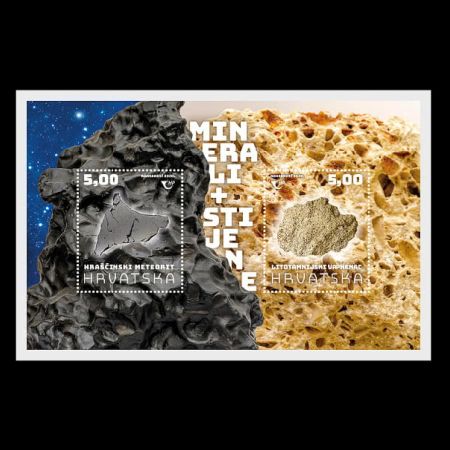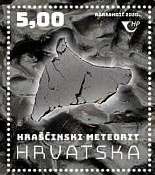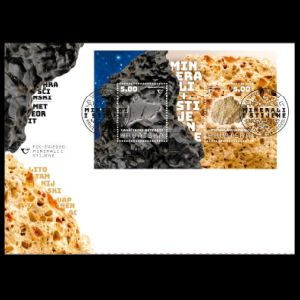the place where Paleontology and Paleoanthropology meets Philately
| <prev | next> |
Croatia 2020 "Minerals & Rocks 2020"
| Issue Date | 22.10.2020 |
| ID | Michel: Scott: UPU: Category: Ot |
| Designer | Dean Roksandić |
| Stamps in set | 2 |
| Value |
5.00HK Hraschina Meteorite 5.00HK Lithothamnium Limestone |
| Size (width x height) |
stamps: 29.82mm x 35.50mm block: 112.00mm x 73.00mm |
| Layout | Block with two stamps |
| Products | FDC x1 |
| Paper | |
| Perforation | 14x14 |
| Print Technique | Offset, multicolor |
| Printed by | AKD doo, Zagreb |
| Quantity | 30.000 |
| Issuing Authority |

The study of rock formation and classification is called petrology, and the study of minerals that the rocks are
composed of is called mineralogy. Rocks form the solid outer shell of the Earth, known as the lithosphere, which
consists of the crust and the solid outermost layer, and reaches up to 100 km in depth. The mantle extends to the depth
of 2900 km underneath the lithosphere, and the core continues to the centre of the Earth, to the depth of 6370 km.
Rocks are aggregates containing one or several types of minerals. Minerals are the products of natural physical and
chemical processes and are characterised by a specific chemical composition and crystal structure, which is stable at
certain temperatures and pressures. The minerals’ regular internal structure reflects on their external form too. Such
regular types of minerals are called crystals.
In terms of formation, rocks are grouped into igneous, sedimentary and metamorphic. Igneous rocks account for about 95%
of the lithosphere, and the other two types account for the remaining 5%. Rocks composed of a single mineral are
referred to as monomineralic, and rock composed of several different minerals as polymineralic.
There are more than 4,700 known minerals today, which are grouped into 14 classes by their chemical composition and
structural properties: native elements, sulphides, sulfosalts, halides, oxides and hydroxides, carbonates, nitrates,
borates, iodates, sulphates, phosphates, arsenates and vanadates, wolframates and molybdates, organic compounds, and the
large group of silicates, which make up more than 95% of the Earth's crust.
Lithothamnium Limestone
Lithothamnium limestone, called “litavac” for short in Croatian, is a sedimentary rock.
 This massive, porous type of limestone is mostly composed of red algae of the Lithothamnium
order that inhabited the Paratethys Sea 15 million years ago, in Middle Miocene.
This massive, porous type of limestone is mostly composed of red algae of the Lithothamnium
order that inhabited the Paratethys Sea 15 million years ago, in Middle Miocene.
The limestone’s name is derived from the algae, in addition to which it contains the remains of
bivalves, echinoderms, bryozoans and benthic foraminifera. Apart from the remains of sea organisms, Lithothamnium
limestone contains fragments of quartz and calcite, mica flakes and fragments of rocks from the coastal area.
Lithothamnium limestone was formed in the shallows of the Pannonian Sea, which surrounded Medvednica and other Pannonian
Croatia mountains, which were islands at the time.
Along with Triassic dolomites, Lithothamnium limestone forms a unique karst zone on the west side of Mount Medvednica.
Even though karst phenomena on Mount Medvednica are mostly hidden under younger Holocene deposits, many karst forms such
as caves, pits, sinkholes and karst valleys are still present in this zone. Mount Medvednica is home to the famous
Veternica Cave, one of the longest in Croatia, with its many canals totalling more than 7000 metres in length, the
Ponikve karst field and other karst forms in the areas of Horvatove stube and in the limestone sections of Lipa and Rog.
Lithothamnium limestone is one of the most commonly used building stones in the City of Zagreb and was used in the
portals of many of its buildings, parts of the arcades at the Mirogoj Cemetery, and the Zagreb Cathedral, dedicated to
the Assumption of the Blessed Virgin Mary and Saints Stephen and Ladislaus, which was built in its present form after
the devastating earthquake of 1880. Lithothamnium limestone for the construction of the Cathedral was brought from the
Gornje Vrapče and Bizek quarries in immediate vicinity of Zagreb, which are now closed, and further stone extraction has
been banned in these locations.
A number of buildings were damaged when Zagreb and its surroundings were hit by a strong earthquake on 22 March 2020,
including the Zagreb Cathedral, whose southern spire collapsed, and the northern spire shifted and destabilised and had
to be removed so as not to collapse too. The damaged spires of the Zagreb Cathedral thus became the symbols of the
earthquake that caused an immense material damage. It will be a while before they are reconstructed, like the rest of
the city.
The Hraschina Meteorite
The Croatian Natural History Museum's collection of extraterrestrial materials (meteorites) comprises some fifty
exhibits from all over the world, but specimens that fell in Croatia (Hrašćina, Miljana and Dubrovnik) are of special
interest.
 The Hraschina Meteorite, also known as “The Zagreb Iron”, has a special place in the collection.
The Hraschina Meteorite, also known as “The Zagreb Iron”, has a special place in the collection.
This iron meteorite fell in the village of Dumovac near Hrašćina in the region of Hrvatsko zagorje on 26 May 1751 at
about 6:00 pm. Meteorites are fragments of a space object, such as a comet, asteroid or meteoroid, which survive the
passage through the atmosphere and fall on the Earth’s surface. Meteorites are divided into three main groups: irons,
stones and stony-irons. Unlike stony meteorites, which resemble the Earth’s rocks, iron meteorites have a higher nickel
concentration than the iron found on Earth. The Hraschina Meteorite played the key role in discovering this fact.
Vienna-based factory owner Alois von Widmannstätten tested the Hraschina Meteorite by etching a polished slab of the
meteorite with nitric acid, which brought out lattice-like patterns. The patterns (lamellae) that have since been used
as the basis to differentiate between terrestrial and extraterrestrial iron are called Widmannstätten patterns, and they
occur due to the separation of the mineral kamacite (Fe and up to 7% Ni) and taenite (Fe and 25-40% Ni).
The Hraschina Meteorite is also important because its fall was recorded in the first official report about the fall of a
meteorite in history. The report written by the Vicar General of the Zagreb Diocese Vuk Kukuljević on 6 August 1751
details how a ball of fire appeared in the eastern sky, and then broke into two in an explosion resembling cannon fire.
The two pieces trailed lines of fire across the sky and produced even stronger explosions on impact. This was the first
record of eyewitness accounts about the fall of a meteorite on Earth in history, compiled at a time when any possibility
of such phenomena occurring was firmly denied. The report and the meteorite are both conserved at the Naturhistorisches
Museum Wien today. The Hraschina Meteorite bears inventory number “1” in one of the world’s oldest meteorite
collections, which suggests that it started the collection.
An illustration in Wilhelm von Haidinger’s book Der Meteoreisenfall von Hraschina bei Agram am 26. Mai 1751 suggests
that two separate pieces fell on the date in question. One weighed approximately 40 kg, and the other 9 kg. The bigger
one was taken to Vienna at the request of Queen Maria Theresa herself, and the whereabouts of the smaller one are
unknown. The Hraschina Meteorite owes its great significance to the fact that it occasioned the first complete
description of a meteorite fall, which provided the format for all future meteorite fall reports. It was the first
record of a meteorite fall in history, followed by a procession of academicians taking turns studying it and a series of
discoveries that transformed the science of astronomy at the time. The fall, witnessed by a number of people, provided
unquestionable evidence that rocks can indeed “fall from the sky”. The Hraschina Meteorite is thus featured in
catalogues and databases across the world as the first meteorite in history whose fall was recorded in a detailed
official report.
A polished slab (weighing only 0.56 grams) and a cast of the Hraschina Meteorite are on display at the Croatian National
History Museum in Zagreb.
| FDC | ||

|
References: Croatian Post, WOPA
| <prev | next> |